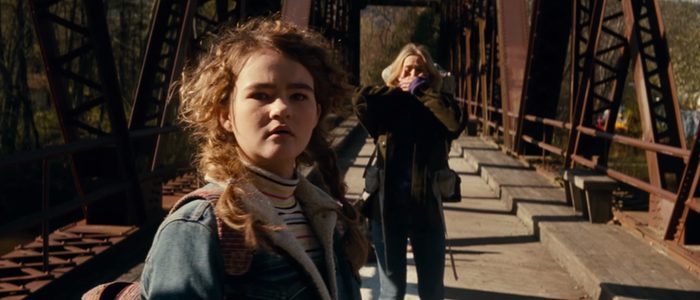
A Quiet Place (2018)
Dir. John Krasinski
The director-aesthetic is currently en vogue in horror, which becomes knotty with the accompanying ‘thinking person’s’ appendage and late capitalist logic of re-presentations-as-innovation. In a twist to postmodern hyper-awareness, anonymity of craft is still having a financially good run (evinced whenever Bay is reviled and the Russo brothers are celebrated), but in smaller budget genre fare pastiche is frequently mistaken for and celebrated as New. A Quiet Place aims to please new horror audiences while displaying a genuine love of the limits and impulses of the genre that make it more than a cynical exercise. Krasinski’s persistent director-aesthetic openly channels Shyamalan’s visual storytelling, wholesome horror, and pervading disquiet, but he breaks from that director in critical ways. The classical compositions and clean early 20th century editing are all there, but that director’s aesthetic context extends to line-readings and performances where Krasinski favours contemporary ‘realism’ in these areas.
The director being both in front of and behind the camera means that A Quiet Place’s sense of intentionalist authority takes on more of a presence than it might otherwise in the playground of negotiated meaning that is the film- the potential for indeterminacy between collaborators and environments is hushed for a clarity of purpose. A Quiet Place’s thesis reads concurrently in its conceit and between the arched anxious wrinkles and scraggliness of the survivalist patriarch beard. This is not necessarily a bad thing- it is the most critically and commercially successful horror movie in years and has received unanimous praise for its consistency of vision and expression. The supposed brilliance of the film is that it is already its own punchline: whatever you’ve heard, however you go on to describe it to people, the summary sentence of the its Wikipedia page, that is what A Quiet Place currently is. This echoes Shyamalan again who frequently turns up as the punchline to jokes about punchlines. Advocates of that director such as myself find that his works actually open up once the punchline is revealed (i.e. on repeated viewings), and it will be interesting to see in time whether A Quiet Place outlives its format.
The irony of the silence here as others have pointed out, is that A Quiet Place is actually exceedingly loud. This is the result of both Krasinski’s anxieties as a young director, which is understandable, and his decision to opt for performances as performances are understood in 2018. The other director I’ll not name again transports melodrama from the past such that emotions and revelations are delivered with the quiet uncanniness of being out of time, stately and deliberate as the films’ aesthetic context. Krasinski’s is communicated in an anxious rush of sweat, tears, and big gestures. The director uses a specificity of material process, namely survivalist process, but employs breathless emotional shorthand to get the audience onboard almost impressionistically with the plight of the central family. This worked for a lot of people, but I felt as though I was always trying to play catch up to a big self-serious charge that didn’t want to wait for me. Visually as well Krasinski tells us too much in an effort to avoid verbal exposition- the Chekhov’s whiteboard appears once as something that’d make a zombie game safehouse designer blush, and then half a dozen more times as farce. As far as emotions are concerned, Krasinski is already well adept at communicating character relationships through composition and shot sequencing, but he has them sign obvious dialogue as well just in case. Marco Beltrami’s score draws attention to the lack of words spoken by filling the perceived gaps with overwrought music that would not be out of place in a dairy commercial. The lack of spoken words is treated as a challenge rather than an opportunity- the director overcomes the challenge, but he could have done more through believing in himself and the audience, and in all likelihood he will do something truly daring with his next effort.
A Quiet Place’s rift is best embodied in its conceit on one side and Krasinski’s beard and wrinkles on the other. One plays things understated, without words, and the other wants to make sure we’ve noticed, and to guide us in how to feel about things. This tension might have been a more readily exploitable facet if we were able to separate the actor from the vision, namely that the work is silly and the faces play it straight. The way the director sets up scares is similar to the gleeful foreshadowing of James Wan’s films, in that they turn the screen into a funhouse where scares could just as easily be swapped out for physical comedy (as they’re both built on expectation and the release of nervous energy). But the severity of the performances in this film emphasise that it’s for drama, for real human stakes, and this gravity has the audience assessing the realism of the setups, as well as the tangible qualities of the people involved. The logical/causal inconsistencies that are revealed in this process can easily be ignored (my day to day life at least is riddled with plot-holes, obvious lapses of judgement, contradictions of character), but this second empathetic hurdle is more difficult to overcome. To get back to emotional shorthand, this would probably be more easy to get on board with if we were not also told through loud scoring, signing, and performances how to feel about things- it wants to bring us in, but it all kept me at a distance.
It’s a beating generous heart that doesn’t fix anything (nor does it profess to), and it’s perhaps too formally conservative for its own good, but this feels like a compromise drawn from nerves rather than depletion or vision, which then at this point can’t help but suggest that there’s more and better to come, which in the terrain of ironic malaise and amnesiac sound and fury is something worth fighting for and celebrating.